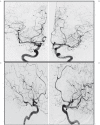Endovascular exclusion of the anterior communicating artery with flow-diverter stents as an emergency treatment for blister-like intracranial aneurysms. A case report
- PMID: 24355152
- PMCID: PMC3902747
- DOI: 10.1177/159101991301900411
Endovascular exclusion of the anterior communicating artery with flow-diverter stents as an emergency treatment for blister-like intracranial aneurysms. A case report
Abstract
Blood blister-like aneurysms (BLAs) are rare lesions, associated with diffuse subarachnoid hemorrhage (SAH). BLAs tend to rebleed quickly after first bleeding and must be treated as an emergency. Acute treatment is challenging using surgical and endovascular approaches due to the fragile aneurysm wall and small sac. Flow-diverter stents (FDSs) may offer a new option for the treatment of difficult small aneurysms. We describe a case of a ruptured BLA on the anterior communicating artery (AComA) treated in the acute phase of SAH by endovascular exclusion of the AComA with deployment of two FDSs in the A1/A2 junctions of both anterior cerebral arteries (ACAs). A 61-year-old man was admitted for diffuse SAH with a focal interhemispheric hematoma. Angiography revealed multiple arterial wall irregularities on the AComA and both ACAs. We performed an endovascular shunt of the AComA by deploying two FDSs in both A1/A2 junctions. Immediate control injections confirmed flow diversion in the A1/A2 segments of the ACAs with decreased blood flow in the AComA. The patient's course in hospital was uneventful. A three-month follow-up angiogram confirmed complete exclusion of the aneurysms, complete exclusion of the AComA, and patency of the two ACAs without any persistent arterial wall irregularity. Endovascular bypass using an FDS for a ruptured BLA has never been described. It establishes a new therapeutic option despite the need for antiplatelet therapy. Endovascular AComA exclusion using an FDS may be a solution when no other treatment is available for a ruptured BLA.
Keywords: blister-like aneurysm; flow-diverter stent; subarachnoid hemorrhage.
Figures






Similar articles
-
Pipeline flow diversion of ruptured blister aneurysms of the supraclinoid carotid artery using a single-device strategy.Neurosurg Focus. 2017 Jun;42(6):E11. doi: 10.3171/2017.3.FOCUS1757. Neurosurg Focus. 2017. PMID: 28565992
-
Ruptured Proximal Anterior Cerebral Artery Aneurysm Treated with Flow Diverter.Turk Neurosurg. 2022;32(1):160-165. doi: 10.5137/1019-5149.JTN.33423-20.3. Turk Neurosurg. 2022. PMID: 34859825
-
Flow diverter devices in ruptured intracranial aneurysms: a single-center experience.J Neurosurg. 2018 Apr;128(4):1037-1043. doi: 10.3171/2016.11.JNS161937. Epub 2017 Apr 7. J Neurosurg. 2018. PMID: 28387623
-
Treatment of ruptured blood blister aneurysms using primary flow-diverter stenting with considerations for adjunctive coiling: A single-centre experience and literature review.Interv Neuroradiol. 2017 Oct;23(5):465-476. doi: 10.1177/1591019917720805. Epub 2017 Jul 31. Interv Neuroradiol. 2017. PMID: 28758550 Free PMC article. Review.
-
Endovascular treatment of blister aneurysms.Neurosurg Focus. 2017 Jun;42(6):E12. doi: 10.3171/2017.3.FOCUS1751. Neurosurg Focus. 2017. PMID: 28565977 Review.
Cited by
-
Flow Diverter Stents for the Treatment of Anterior Cerebral Artery Aneurysms: Safety and Effectiveness.Clin Neuroradiol. 2017 Mar;27(1):51-56. doi: 10.1007/s00062-015-0441-8. Epub 2015 Aug 7. Clin Neuroradiol. 2017. PMID: 26250557
-
Blister-like aneurysm of the anterior communicating artery treated with only Low-profile Visualized Intraluminal Support Junior stent.Surg Neurol Int. 2021 Nov 16;12:564. doi: 10.25259/SNI_923_2021. eCollection 2021. Surg Neurol Int. 2021. PMID: 34877050 Free PMC article.
-
Mid A1 blister aneurysm presenting with subarachnoid hemorrhage: Case report and review.Brain Circ. 2018 Jan-Mar;4(1):19-23. doi: 10.4103/bc.bc_2_18. Epub 2018 Apr 18. Brain Circ. 2018. PMID: 30276332 Free PMC article.
-
Are Flow Diverting Stents a Treatment Option in Acutely Ruptured Complex A1-A2 Junction Aneurysms?Clin Neuroradiol. 2016 Mar;26(1):109-15. doi: 10.1007/s00062-015-0407-x. Epub 2015 May 24. Clin Neuroradiol. 2016. PMID: 26003172 No abstract available.
-
Use of flow diverters in the treatment of unruptured saccular aneurysms of the anterior cerebral artery.J Neurointerv Surg. 2017 Mar;9(3):283-289. doi: 10.1136/neurintsurg-2016-012648. Epub 2016 Oct 27. J Neurointerv Surg. 2017. PMID: 27789789 Free PMC article.
References
-
- Ezaki Y, Takahata H, Kamada K, et al. Aneurysmal embolization of a blisterlike aneurysm of the internal carotid artery: a case report and review of the literature. Surg Neurol. 2006;65(6):628–630. discussion 630. - PubMed
-
- Park JH, Park IS, Han DH, et al. Endovascular treatment of blood blister-like aneurysms of the internal carotid artery. J Neurosurg. 2007;106(5):812–819. - PubMed
-
- Meling TR, Sorteberg A, Bakke SJ, et al. Blood blister-like aneurysms of the internal carotid artery trunk causing subarachnoid hemorrhage: treatment and outcome. J Neurosurg. 2008;108(4):662–671. - PubMed
-
- Lee BH, Kim BM, Park MS, et al. Reconstructive endovascular treatment of ruptured blood blister-like aneurysms of the internal carotid artery. J Neurosurg. 2009;11(3):431–436. - PubMed
-
- Lee JW, Choi HG, Jung JY, et al. Surgical strategies for ruptured blister-like aneurysms arising from the internal carotid artery: a clinical analysis of 18 consecutive patients. Acta Neurochir (Wien) 2009;151(2):125–130. - PubMed
Publication types
MeSH terms
LinkOut - more resources
Full Text Sources
Other Literature Sources
Medical

